Top Angola Attractions
Things to do in angola, explore popular experiences, popular cities in angola.
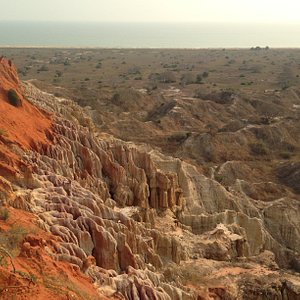

Top Attractions in Angola
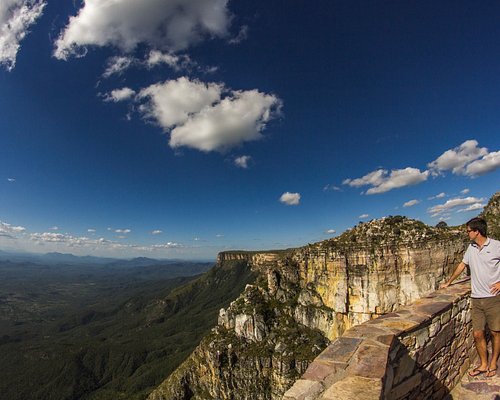
Nature and Wildlife Tours

Cultural Tours

Historical Tours
Multi-day tours.

Tours & Sightseeing
What travelers are saying.
16 Angola Tourist Attractions – 16 best things to do in Angola
Angola is probably one of the last countries you will consider a tourist destination. Yet it’s one of the most beautiful countries we have visited, full of incredible natural tourist attractions.
We had the privilege of working in Angola for three years, which allowed us to see the natural beauty of the country. In other political circumstances, Angola would be a top travel destination in Africa, and visiting Angola would be a must for any travel lover!
If you are lucky enough to travel to Angola any time soon, these are the tourist attractions to put on your list!
Page Contents
Best things to do in Luanda, Angola
Luanda is the capital of Angola, its financial and political center, and its biggest city. Still, it’s not a tourist destination, but many people travel to Luanda for business. It’s a lively city but chaotic, quite dangerous, and has insane traffic. However, it has many famous landmarks , beaches, and beautiful sights.
#1 Ilha de Luanda (Island of Luanda)
It’s not really an island but a small peninsula. It stretches for 5 km right in front of Luanda. It’s home to some good beaches, restaurants, and bars. The Ilha is a much-visited place in Luanda and the go-to place for nightlife and a party!
Some beaches are inside the restaurants/bars perimeter and, therefore, more private; others are entirely public. The sand is soft, the water is warm, and it’s summer for at least nine months of the year. However, these aren’t the cleanest beaches and can get crowded.

#2 Ilha do Mussulo (Island of Mussulo)
If you think the Island of Luanda blessed Luanda, wait until you hear about Mussulo! In the southern outskirts of Luanda, Mussulo is a 30 km long tongue of land/sand. The water is even warmer than in the rest of Angola and without waves, creating a vast lagoon-like environment in the sea. To go there, you should get a boat from the “mainland.”
Mussulo is so close to Luanda’s chaos, but you have a completely different and chilled vibe there. If you are visiting Luanda, you must come here. Just perfect for relaxing under the sun and forgetting about the day to day problems for a few hours or a weekend. It is, of course, beautiful, with a long beach, warm seawater, palm trees…

#3 Marginal de Luanda
It’s a long avenue/boulevard from Luanda’s Port to Luanda’s Island. It was renovated a few years ago, and it’s now the favorite spot for Angolans and Expats to walk or run in Luanda. You have a nice view of the island and the city skyline from here.

Right in front of it are a few landmarks and beautiful buildings of Luanda.
- Angola’s National Bank – An imposing pink building built in the colonial era! In our opinion, it’s the most beautiful building in Luanda.

- Currency Museum – Right next to Angola’s National Bank, there’s a currency museum. There was quite a big noise about it and how much money it was spent. However, it’s a good museum with quite a few interactive features and some information. Worth a visit.

- S. Miguel Fort – The fort is at the top of a small hill, so you must climb a “few” stairs. However, you will be rewarded with a fantastic view of the Marginal, the island, and the city.

Angola Tourist attractions on the outskirts of Luanda
These are a few awesome places that are very close to the city of Luanda but not really in the city. You are better off visiting these on a day trip from Luanda or even a small weekend escapade.
#4 Miradouro da Lua
Miradouro da Lua translates to Moon’s Lookout. Not because it’s a great place to look at the moon (which probably is) but because it’s a lunar landscape.
The erosion of the rain and the wind created this unique landscape. The bright colors of the land just make it even more special. This is right on the main road to southern Angola, so it’s a great stop to stretch and enjoy the view.

#5 Go to Kissama National Park
Kissama National Park is the place to go if you want to do a Safari in Angola . It’s about 75 km south of Luanda, thus close enough to easily do a day trip and far enough to be completely outside the city’s influence.
Most of its animals were killed during the colonial and civil war; however, it has been repopulated, and we can see some animals during a safari. Yet don’t expect it to be like the Kruger or Chobe. 🙂 Though, in terms of the natural setting and flora, it’s on par or even better! Read this for a full safari in Kissama experience.

#6 Beaches of Cabo Ledo and Sangano
Almost 100 km south of Luanda and without any other city close, you find the beaches of Sangano and Cabo Ledo. Both beaches are in a bay and have perfect yellow sand and beautiful blue seawater.
These beaches are usually full of expats on Saturdays and Sundays because it’s popular as a weekend retreat.

Best tourist attractions in Angola – Malanje
Malanje is the center north of Angola, roughly 400 km from Luanda, and it will take about 6 or 7 hours to get there. The city itself is fascinating but nothing really unique; however, the province has some of the most spectacular Angolan tourist attractions.
#7 Rapids of Kwanza
Kwanza is a big river with a considerable flow. Thus, the final drop of 5 or 6 meters of the rapids makes a powerful waterfall. It’s an impressive image that will stay with you long.
You can swim in the flat water above and below the fall. You have to drive through a big village to get to the rapids thus, you will be loudly received by the children when arriving.

#8 Black stones of Pungo Andongo
The black stones of Pungo Andongo are a series of rock formations standing high above the African Savanna. Some say the rocks look like different animals, and some don’t, but the rocks are impressive and mysterious.
It is possible to climb to the top of one of the rocks called “male stone.” From up there, you get a beautiful and soothing view of the other rocks, the savanna, and the Kwanza River on the horizon.

#9 Kalandula Falls
Kalandula Falls are the biggest attraction in Malanje and probably in Angola. These falls are sometimes dubbed the 2nd most impressive in Africa (after Victoria Falls). Located in the Lucala River, the falls are over 100 meters high and 400 meters wide.
These are particularly impressive during the rainy season when the Lucala is at full flow. One can hire a guide (usually a kid) to descend to the bottom, where the view and the proximity to the waterfall make the experience much more intense. We definitely recommend it.

Benguela, Angola – Tourist attractions
Benguela province is home to some of the most beautiful beaches in Angola. We had the privilege of visiting Benguela and liked the slower lifestyle and the more relaxed feeling. Benguela is very different from Luanda.
#10 Restinga in Lobito
Remember what we wrote about the Island of Luanda? Well, there’s a version of it in Lobito, and it’s called Restinga! Restinga is a slightly smaller 5 km long and has little traffic (which is sometimes a problem on the Island); the sand and water are cleaner than in the Capital city and, as always in Angola, warm.
As expected, you get the usual restaurants and bars but less massive than in Luanda… Angola is blessed with these kinds of beaches!

#11 Beaches of Benguela
In general, Angolan beaches are amazing , but the ones around Benguela are the best in Angola. Our two favorites are Baia Azul and Baía Farta.
Baía Azul (blue bay) is 3 km long with soft, clean sand and deep blue seawater. It’s considered the main beach of Benguela and great for relaxing and playing in the sand. The warm waters make it perfect for swimming and even for water sports.

Baía Farta is a fishing village/town and loosely translates to a bay of plenty. With very few people, it’s very different from Baía Azul; however, the scenery is even better. As you approach the water, you realize the beautiful scenery and the privilege of having to yourself (or barely so) a world-class beach.
After 300 meters of walking in the sand under the strong African sun, diving in that blue/turquoise and crystal clear is heavenly.

#12 Binga Falls
Not really in Benguela province, but in South Kwanza province. It’s only in this category because it’s a mandatory stop for a road trip from Luanda to Benguela .
The Binga waterfall is in the Keve River on the way to Gabela. They are very impressive and have a considerable flow in the rainy season. The old colonial bridge gives it a unique charm.

Places to visit Lubango and Namibe
You probably noticed that we really liked the beaches in Benguela, but those aren’t our favorite attractions in Angola! That title is reserved for the region of Lubango. We had the pleasure of spending a long weekend there. The scenic mountains, the great food, and the perfect getaway resort called Pululukwa got into our hearts!
#13 Tundavala Gap (Fenda da Tundavala)
Fenda da Tundavala is an enormous abyss in the mountain of Serra da Leba, located only 18 km from Lubango. The mountain plateau has 2200 meters of altitude and suddenly falls 1000 meters creating an abyss. It looks like somebody cut a slice of the mountain.
This natural abyss promotes stunning views. It is one of the great natural wonders of Angola.

#14 Serra da Leba
Serra da Leba is only 50 km from Lubango, though it’s already in the province of Namibe. The most stunning part of the mountain is the mountain pass road with 56 curves, built during the colonial era to connect the cities of Lubango and Namibe.
Don’t forget to go to the viewing point of Serra da Leba, where you can see the whole picture of the mountain and the pass and take awesome photos.

#15 Namib Desert
The Namib desert goes from the South of Angola to South Namibia and ranges 1600 km. Unfortunately, we didn’t have a 4WD to venture into the desert, but we had the opportunity to explore the Namibian part of the desert during our escapade to Swakopmund . This is one of the aridest regions in the world and where you will find the unique Welwitschias.

#16 Pululukwa resort
The Pululukwa resort is ideal for relaxing and enjoying the scenery and nature. You will find wild animals, zebras, antelopes, Angolan chickens, and even Ostriches and crocodiles throughout the park. With 100 acres and remarkable treks, you have a lot to explore: wooden paths, several lakes, different resting points, and fruit farms.
We also need to mention the restaurant in Pululukwa because it is fabulous! There are great (and expensive) restaurants in Angola (particularly in Luanda), but the one in Pululukwa is our favorite.

Although we lived in Angola , we didn’t visit the whole country! Angola is huge, so there are many other places that we couldn’t travel to or just weren’t even aware existed.
We understand that not many people will be able to travel to Angola; it is, after all, one of the least touristy destinations in the world. However, it’s also a fantastic country with a lot to offer to the few who can visit Angola and get to know it. If you have the opportunity, seize it!
Sharing is caring!
2 thoughts on “16 Angola Tourist Attractions – 16 best things to do in Angola”
Wow! Haven’t heard of most of these locations! Adding to my bucketlist!
Yes, Angola is definitely not a place most of us think about when you plan a vacation, but like you show, there is much to offer here.
Comments are closed.
Top Things to Do in Angola
Places to visit in angola, explore popular experiences, popular cities in angola.

Top Attractions in Angola

Nature and Wildlife Tours

Cultural Tours

Historical Tours
Multi-day tours.

Tours & Sightseeing
What travellers are saying.
Must-see attractions in Angola

Parque Nacional da Kissama
Kissama (also spelt Quiçama), situated 70km (43.5mi) south of Luanda, is Angola's most accessible and well-stocked wildlife park. This huge swathe of…
Museu de Antropologia
The Fortaleza de São Miguel guarding the entrance to the bay was constructed by the Portuguese in 1576 and is Luanda's oldest surviving building. Altered…
Museu Central das Forças Armadas
Banco Nacional de Angola
The curvaceous sweep of the harbour-side Marginal makes an interesting stroll at any time of day. Look out for the striking domed pink façade of the Banco…
Palácio de Ferro
Architectural buffs will also want to check the Palácio de Ferro , designed by Frenchman Gustave Eiffel (of Eiffel Tower fame) in the 1890s for the Paris…
Tunda-Vala Volcanic Fissure
Largely unaffected by the war, Lubango provides access to the beautiful beaches of Namibe. En route, watch for the Tunda-Vala volcanic fissure, where you…
Igreja de Nossa Senhora de Nazaré
Luanda has a smattering of old colonial churches hidden among the skyscrapers. A bit of careful searching will reveal the diminutive Igreja de Nossa…
Igreja de Nossa Senhora dos Remedios
See the impressive double-domed façade of the Igreja de Nossa Senhora dos Remedios , built in 1655 and restored in 1995.
Museu de História Natural
The Museu de História Natural boasts two permanent exhibitions in its marine and mammal halls.
More destinations you need to see
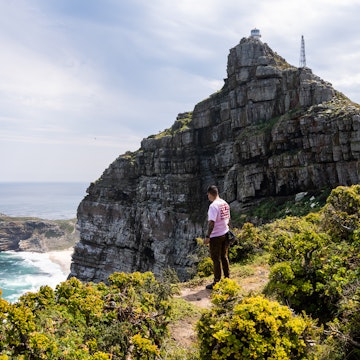

- Tips & Budget
Top 12 Tourist Attractions in Angola
Unveil the allure of top tourist attractions in angola and embark on a remarkable journey..
Discover the best tourist attractions in Angola and unlock a world of hidden gems. Angola might not be the first place that pops into your mind when you think of tourist destinations, but trust me; it’s a hidden gem with some truly breathtaking attractions waiting to be explored. Angola’s tourist attractions offer a blend of natural beauty, cultural richness, and unique experiences. From the captivating coastlines of Ilha de Luanda and Ilha do Mussulo to the lunar landscape of Miradouro da Lua, there is something for every type of traveler. Kissama National Park provides an opportunity to embark on a safari adventure, while the beaches of Cabo Ledo and Sangano offer a relaxing retreat. The rapids of Kwanza and the breathtaking Kalandula Falls showcase the power and beauty of Angola’s natural wonders.
What is one of the most famous attractions in Angola Why?
One of the most famous attractions in Angola is Kalandula Falls, located in Malanje. These falls are renowned for their grandeur and are often considered the second most impressive falls in Africa, following the mighty Victoria Falls. Standing at over 100 meters high and stretching 400 meters wide, Kalandula Falls captivate visitors with their sheer size and natural beauty. The powerful rush of water cascading down creates a mesmerizing spectacle that leaves a lasting impression. The falls are a popular tourist destination, drawing visitors from around the world who are eager to witness the breathtaking splendor of this natural wonder in Angola.
1. Ilha de Luanda (Island of Luanda)
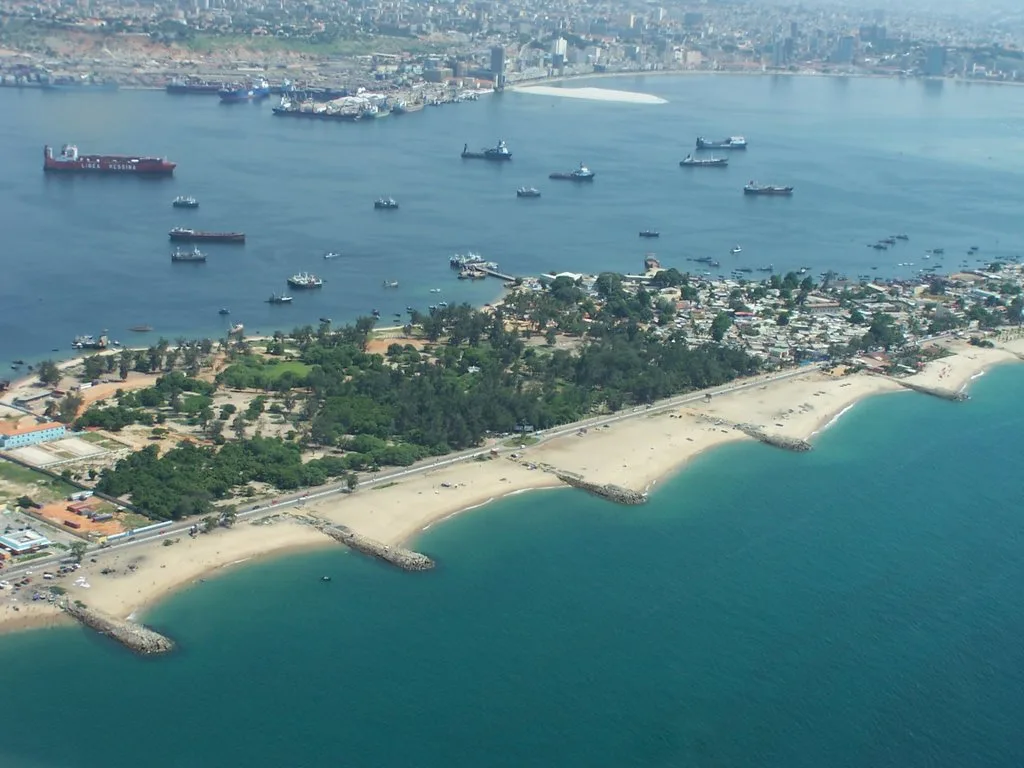
Although it’s technically a peninsula, this 5 km stretch right in front of Luanda is a hot spot for nightlife and beach fun. The soft sand and warm waters make it a popular destination, but be aware that it can get a bit crowded.
2. Ilha do Mussulo (Island of Mussulo)
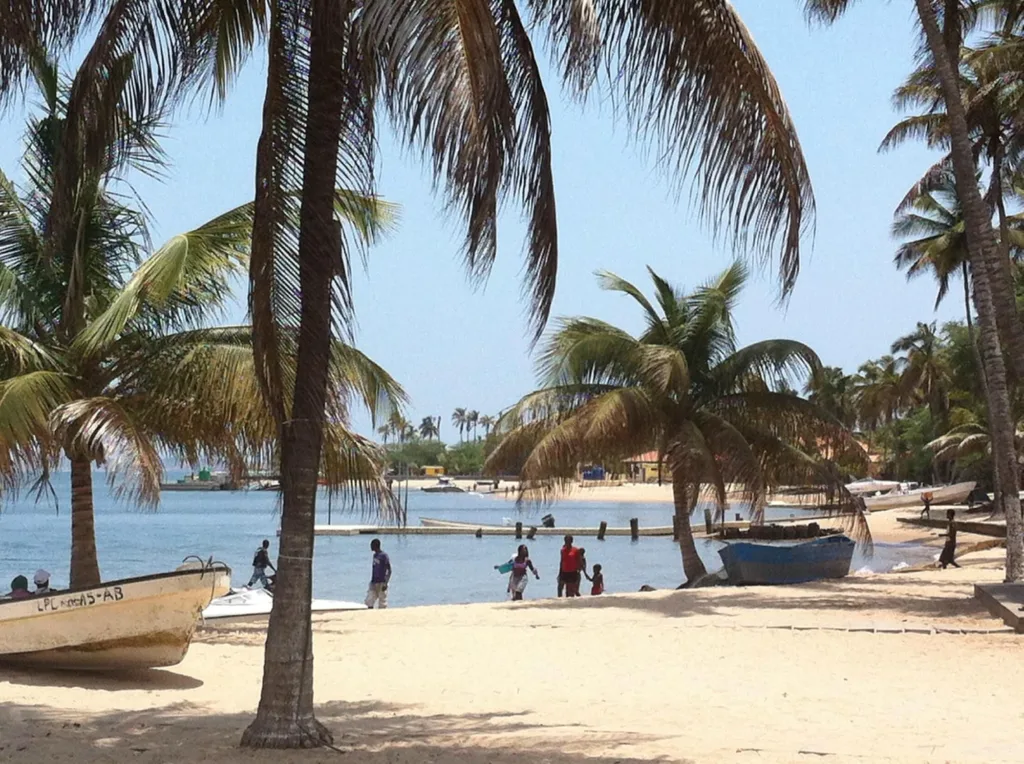
Prepare to be enchanted by Mussulo, a 30 km long sandy tongue located in the southern outskirts of Luanda. The calm waters create a lagoon-like environment, perfect for a relaxing getaway. Hop on a boat from the mainland to reach this little paradise.
3. Marginal de Luanda

This long avenue/boulevard stretches from Luanda’s port to the Island of Luanda. Recently renovated, it’s a favorite spot for locals and expats to stroll or jog while enjoying stunning island and city skyline views.
4. Miradouro da Lua
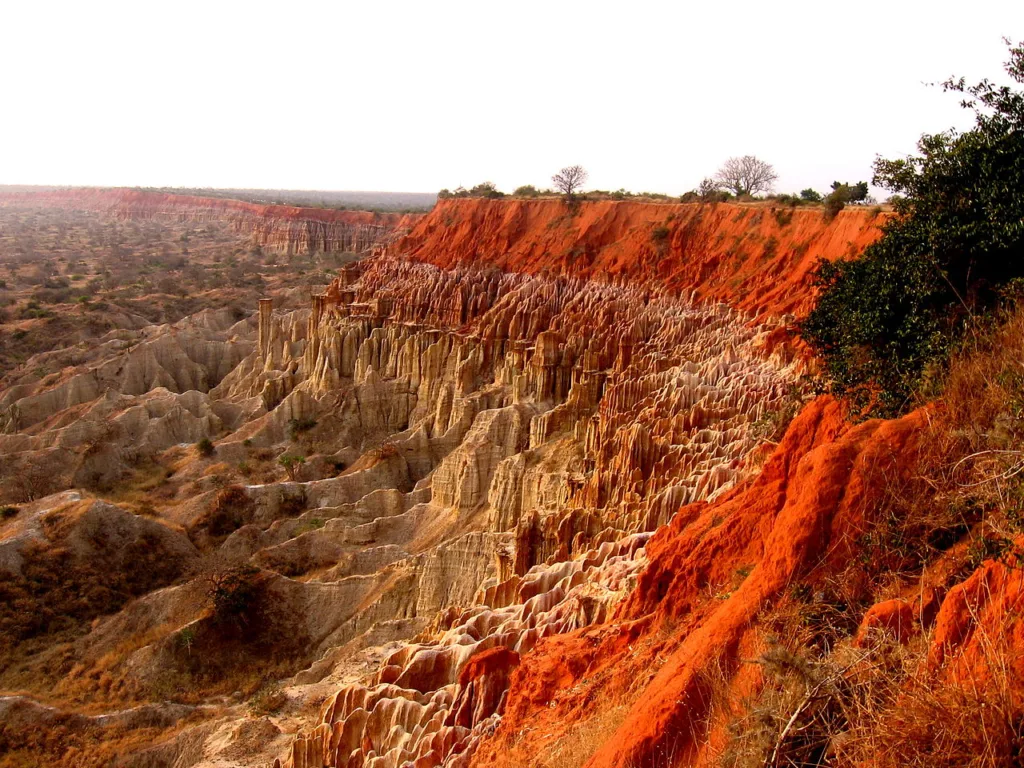
Known as the Moon’s Lookout, this unique spot offers a lunar-like landscape created by erosion from rain and wind . The breathtaking colors of the land make it a must-visit place along the main road to southern Angola.
5. Kissama National Park
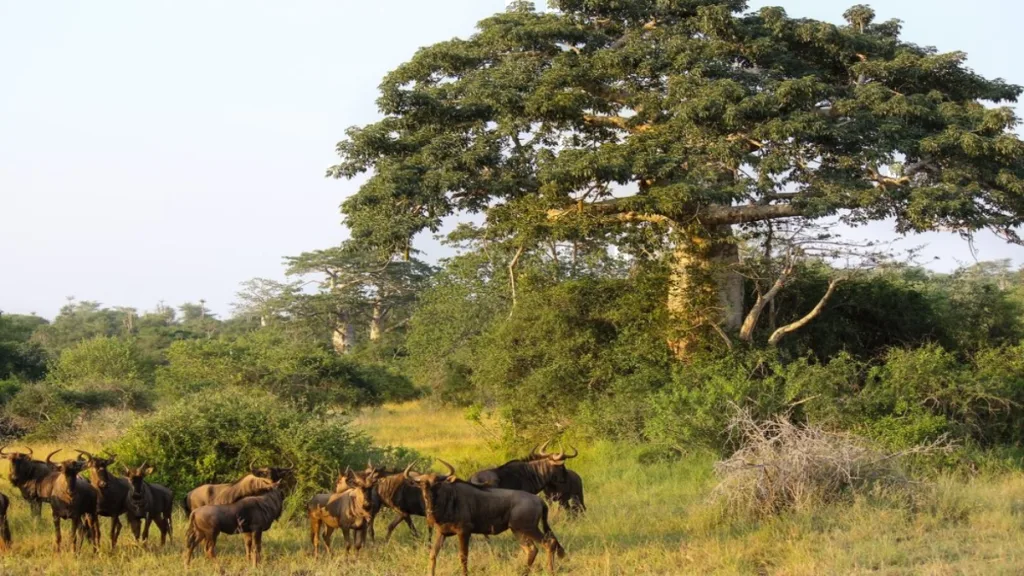
Want to experience a safari in Angola? Head about 75 km south of Luanda to Kissama National Park. While it may not be as dense with wildlife as some other parks, the natural setting and flora make it a special place to explore.
6. Beaches of Cabo Ledo and Sangano
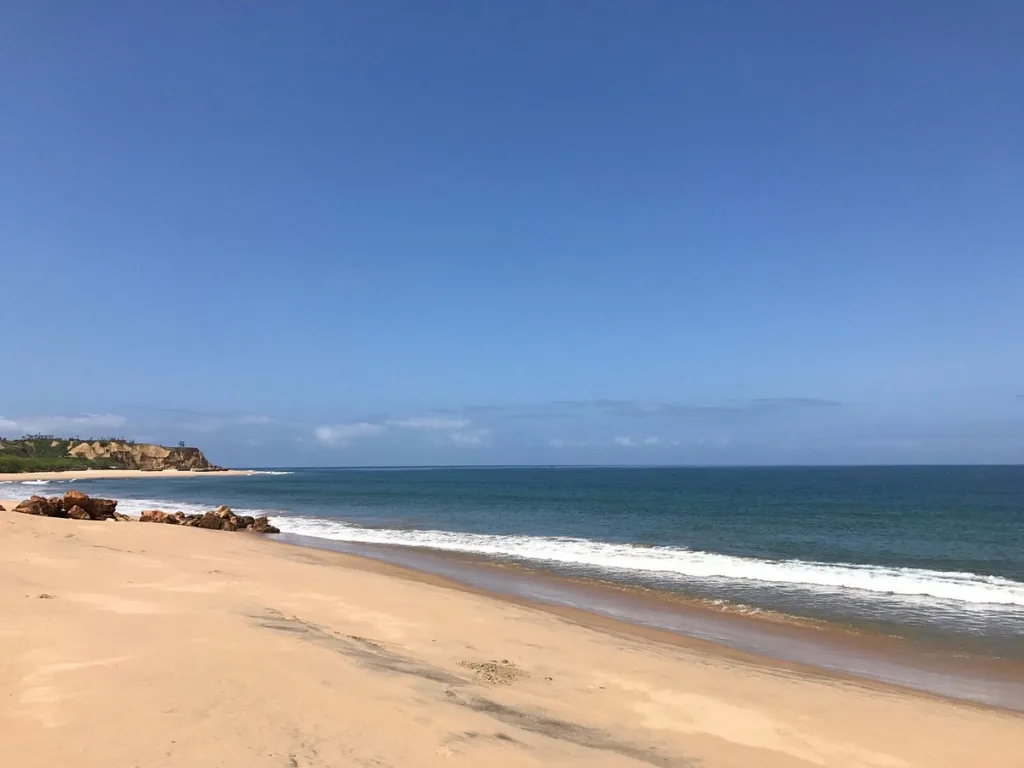
Cabo Ledo and Sangano beaches are perfect for you if you’re craving some sun and sand. About 100 km south of Luanda, they offer yellow sandy beaches and crystal blue waters, making them popular weekend getaways for expats.
7. Rapids of Kwanza
The powerful waterfall created by the final drop of Kwanza River’s rapids is impressive. You can swim in the calm waters above and below the fall, but prepare for a warm welcome from the local children as you approach the area.
This port town offers a unique blend of beach and desert landscapes. Visit Arco Lagoon and parts of Iona National Park to experience the region’s natural beauty. Namibe also provides insights into the lives of the Mucubais tribe people.
9. Namib Desert
Welcome to the oldest desert on Earth! The Namib Desert captivates from Tombwa to Walvis Bay in Namibia with its red sand dunes and rock formations. The Cunene River adds to its beauty, making it a mesmerizing coastal sight.
10. Leba Mountain Pass
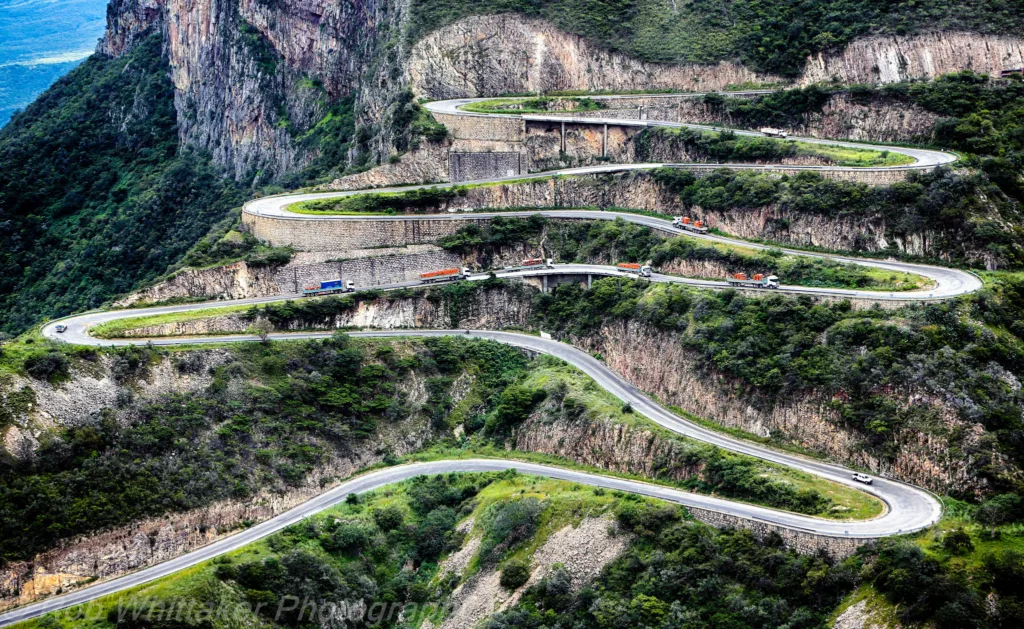
Thrill-seekers, this one’s for you! The winding roads of Leba Mountain Pass offer an adrenaline-pumping joy ride, reaching heights of up to 5,000 feet. As you ascend from Lubango to Namibe, you’ll be treated to lush forests and cascading waterfalls against the backdrop of the desert below.
11. Iona National Park
The largest national park in Angola, Iona covers a whopping 5,850 square miles. While its wildlife population suffered during the civil war due to poaching, efforts are underway to revive its natural splendor. The park’s rock formations offer picture-perfect views and great opportunities for photography.
12. Kalandula Falls
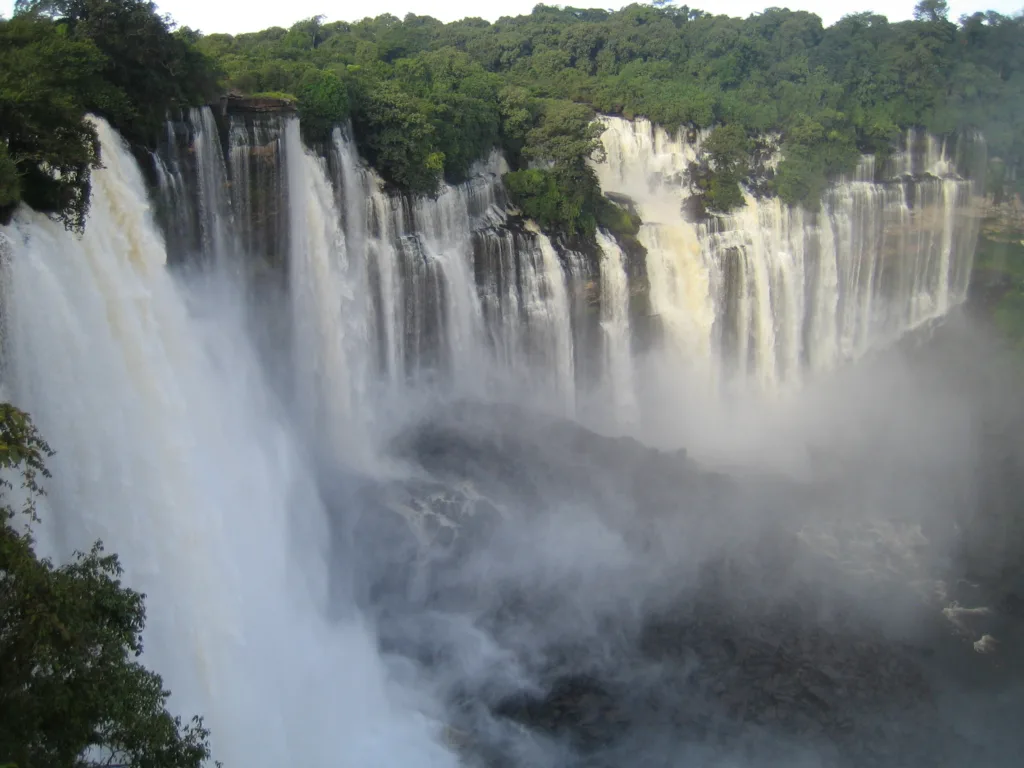
Prepare to be amazed by the magnificent Kalandula Falls, often considered one of the most impressive falls in Africa after Victoria Falls. Located in the Lucala River, these falls stand over 100 meters high and stretch 400 meters wide. For an intensified experience, hire a local guide to descend to the bottom and get up close and personal with the waterfall.
Is Angola good for tourists?
While Angola has many attractions and unique experiences for tourists, it is important to consider the current travel advice and safety precautions. The Australian government’s Smartraveller website advises exercising high caution in Angola overall due to the risk of civil unrest and violent crime.
It is crucial to stay informed about the current security situation, follow the advice of local authorities, and take appropriate safety measures. This may include avoiding demonstrations or large gatherings, staying in secure accommodations, and being vigilant with personal belongings.
What is the most beautiful city in Angola?
Luanda is the most beautiful city in the country. With its stunning coastal location, modern infrastructure, and a mix of architectural styles, Luanda offers a unique blend of natural and man-made beauty.
The city boasts a range of attractions that contribute to its charm. Its luxurious state is reflected in the quality infrastructure, hotels, resorts, and restaurants that cater to visitors. Like Ilha de Luanda and Ilha do Mussulo, Luanda’s beaches provide picturesque spots for relaxation and water activities.
Monuments and historical sites, like the National Museum of Angola and the Fortress of São Miguel, offer a glimpse into the country’s rich cultural heritage. For nature enthusiasts, the Kissama National Park, located just outside the city, is home to diverse wildlife and beautiful landscapes. Luanda also offers modern amenities, such as mega malls, entertainment centers, and vibrant nightlife, making it an appealing destination for both leisure and business travelers.
While beauty is subjective, Luanda’s combination of natural scenery, architectural splendor, cultural heritage, and modern amenities contribute to its reputation as one of Angola’s most visually appealing cities.
What is Angola best known for?
Angola is indeed well-known for its significant oil production and export industry. The country has abundant oil reserves and has emerged as one of Africa’s leading oil producers. Angola’s oil industry is crucial to its economy, contributing significantly to government revenue and foreign exchange earnings.
Bottom Line
These are just a taste of the incredible attractions Angola has to offer. Whether you’re seeking beachside relaxation, thrilling adventures, or a glimpse into the country’s rich culture and history, Angola won’t disappoint. Pack your bags and get ready for an unforgettable journey!
Subscribe to our newsletter to get our newest articles instantly!
Leave a Reply Cancel reply
Your email address will not be published. Required fields are marked *
Save my name, email, and website in this browser for the next time I comment.
WhatsApp us

Sign in to your account
Username or Email Address
Remember Me

Home » Travel Guides » Angola » 15 Best Things to Do in Luanda (Angola)
15 Best Things to Do in Luanda (Angola)
The capital of Angola , Luanda sits on the coast of the Atlantic Ocean and is divided into two parts; Baixa de Luanda and Cidade Alta. It is the administrative, cultural and urban centre of the country, as well as being the third most populous Portuguese speaking city on the world. It is a fast growing city, with major reconstruction and development projects popping up all over the city, which has attracted numerous Portuguese immigrants over the past few years.
Luanda’s thriving business industry has made it quite an expensive city to visit, though this should not discourage you. Its new infrastructure means that it is a very comfortable city for tourists to visit, and, mixed with its warm climate, it is quite an appealing destination. There are also plenty of things to do both in the city and just outside of it.
Lets explore the best things to do in Luanda :
1. Visit the Saint Michael Fortress

This Portuguese fortress was built in 1576 by Angola’s first Captain-Governor Paulo Dias de Novais. It was once the administrative centre of the country and, unfortunately, became a holding place for slaves being sent to Brazil.
One of the things that is most beautiful about the fortress are the ornate wall tiles that tell the story of Angola’s history. It also displays plenty of other ancient relics.
In 1996 the Saint Michael Fortress became a UNESCO World Heritage site. Since then, it has become one of the most popular places to visit in the city.
2. Learn about the city’s contribution to slavery

The National Museum of Slavery (Museu Nacional da Escravatura) was founded in 1977. It is a small white building that sits along the city’s coastline.
Luanda’s history in the slave industry is not a pretty one, but those who want to learn more about it should definitely head to this museum. It displays photos and lithographs hanging on the walls telling the story.
Angola was one of the largest slave-traders along the west coast of Africa. The site where the museum sits is where slaves were baptised before being put on ships heading to the USA.
3. Walk along the harbour

Avenida 4 de Fevereiro, which is also known as Marginal, runs parallel to the Luanda Bay and is a great place for a nice stroll. Not only does it boast great views of the sea and the boats coming in and out of the port, but it is also lined with some beautiful buildings, like the Banco de Angola.
At one end of the avenue is the port, which is famous for its clock tower, while the old fort sits at the other end. It is the most prestigious street on the city and where many of its luxury hotels can be found.
Avenida 4 de Fevereiro is named after the struggle of independence in Angula, which was also the beginning of the Portuguese Colonial War.
4. Pay your respects to the first President

António Agostinho Neto was Angola’s first president after its independence from Portugal. He led the Popular Movement for the Liberation of Angola and was president from 1975 to 1979.
The iconic Agostinho Neto Mausoleum can’t be missed, as it is one of the most dominating structures in Luanda. The structure towers over the rest of the city, which, in addition to being a mausoleum, is also a museum.
It takes around 20 minutes to tour the structure, where there are numerous photos of him with other political leaders around the world, including Che Guevara, Fidel Castro and Honecker.
5. Go to church

The Roman Catholic Cathedral of the Holy Saviour (Sé Catedral de Luanda) is a lovely church that was built in 1628. It is the seat of the Roman Catholic Archbishop of Luanda.
The church has been an important part of the country’s religious history, though in 1877 it was completely ruined. It was rebuilt between 1880 and 1900, which is what you will see today.
The church features three curved doors at the entrance, which are bordered by one larger curved façade. The cathedral was declared a building of Public Interest in 1949.
6. Wander around a palace

The Palácio de Ferro (Iron Palace) is a magnificent palace that was built in the city by world-renowned architect Gustave Eiffel. It is not as iconic as the builder’s other structures, but it is a stunning piece of architecture.
It is believed that the palace was built in France with the idea to have it moved to Madagascar by boat, but instead it ended up along Angola’s Skeleton Coast due to drifts from the currents. Portuguese rulers than brought it to Luanda.
It is a striking yellow building with fine wood details and decorative fencing. It has recently opened up as a diamond museum.
7. Mingle with wildlife

Quiçama National Park is the country’s only functioning national park. It sits around 70 kilometres from the city and makes for a popular safari day trip.
The 12,000 square kilometre park opened as a game reserve in 1938, but became a national park in 1957. Today, it is at the forefront of Angola’s wildlife.
The animal population in the park is thanks to a Noah’s Ark type operation where animals were transported here from Botswana and South Africa. Before that the animal population was quite low due to poaching in previous years.
8. Go surfing

Just a few hours south of Luanda is the world famous surfing beach of Cabo Ledo. The beach has one of the world’s longest point breaks at 500 metres.
Cabo Ledo features a long slow left, making it a great place for beginners to surf. It is a consistent place to surf and is certainly a world-call surfing destination.
The beach is also home to some quint bungalows, so it is also a great place to spend a night. Though it can easily be accessed in a day from the capital city.

9. Head to the mall

Belas Shopping is the country’s first modern mall and is not only a great place to shop, but also a great way to escape a hot day. The 120,000 square metre mall opened in 2007.
It is a large mall that is home to eight cinemas, an entertainment area, a food court and over 100 stores. There are also banks and a supermarket within the mall.
The majority of stores in Belas Shopping are local shops, making it a great place to look for and learn about local brands.
10. Enjoy a glamorous night

Head to the phenomenal Epic Sana Luanda hotel for a delicious meal and a unique night out. The five-star hotel is not far from Avenida 4 de Fevereiro and boasts great views of the bay.
First, dine in one of its fabulous restaurants, like Origami, which boasts spectacular views of the bay. Or feast on Italian at the hotel’s Vitrúvio Restaurant that features a superb wine collection.
After your meal, enjoy a cocktail or a glass of wine at the lobby Kosmopolis Bar. For something really unique, dance the night away at the chic Switch Supper Club, which is open on the weekends until 6am!
11. Go to the moon

The magnificent Miradouro da Lua is a landscape that sits around 40 kilometres outside of the city. It is famous for its moon-like surface, giving visitors the feeling that they are actually on the moon.
Translated to ‘Moon Valley Viewpoint’, Miradouro da Lua was formed by cliffs with sharp pinnacles that has been eroded from the wind and the sea. This gives it its moon-like surface.
It is an impressive site and one of the top attractions outside of Luanda. A day trip here should not be missed.
12. Relax on a beach

Just south of Luanda is the peninsula of Mussulo, which is known for its beach. It is not only a popular place for Luandans, but also for tourists.
The peninsula is 30 kilometres long and 3 kilometres wide, boasting a lovely beach that offers great views of the city. There are beach huts and restaurants lined along it, as well as a few hotels and resorts.
13. Learn about Angola’s history

In addition to the National Museum of Slavery, there are also a couple of other great museums in Luanda that are much less depressing. They tell another part of Angola’s history.
The National Museum of Natural History displays numerous animals that either inhabit or once inhabited the country. Fish, insects and birds are displayed, as are other diverse organisms.
The National Museum of Anthropology is dedicated to educating people about the country’s history and culture. It displays an impressive collection of traditional masks, sculptures, jewellery, musical instruments, weaponry and clothing.
14. Shop for local handicrafts

The Benfica Market is by far the best place to shop for local handicrafts in Luanda. It is just south of the city centre and best visited with a guide to ensure that you get the best deals imaginable.
The market has all kinds of handicrafts, including paintings, jewellery, textiles and baskets. It is also, unfortunately, known for its ivory trade.
Bargaining is key here if you want to snag the best deals. The market is also a great place to people watch.
15. Visit a national monument

The Fortress of São Pedro da Barra sits on a hill overlooking the city. The fortress dates back to the 16th century and was built on the ruins of Morro de Kassandama.
The fort became a national monument in 1932. Today, it is on UNESCO’s tentative list of for its historical importance.
The Fortress of São Pedro da Barra later became a holding place for slaves that were being shipped to the USA. More recently, it was used as a prison for arrested nationalists during Angola’s war of independence.
15 Best Things to Do in Luanda (Angola):
- Visit the Saint Michael Fortress
- Learn about the city’s contribution to slavery
- Walk along the harbour
- Pay your respects to the first President
- Go to church
- Wander around a palace
- Mingle with wildlife
- Head to the mall
- Enjoy a glamorous night
- Go to the moon
- Relax on a beach
- Learn about Angola’s history
- Shop for local handicrafts
- Visit a national monument
- 3 Other destinations
- 4.1.1 Angola as a Portuguese colony (15th century - 1975)
- 4.1.2 Angolan Civil War (1975 - 2002)
- 4.1.3 Present day (2002 - present)
- 4.2 Climate
- 4.3 Electricity
- 4.5 Books about Angola
- 4.6 Information about Angola
- 6.1 Entry requirements
- 6.2 By plane
- 6.3 By train
- 6.6 By boat
- 7.2 By train
- 7.3 By ferry
- 7.4 By plane
- 10.2 Shopping
- 11.1 Signature and national dishes
- 14.2 Political unrest
- 14.3 Photography
- 15 Stay healthy
Angola is a beautiful nation in Central Africa endowed with beautiful waterfalls, rivers, national parks, and coastlines. There is plenty to do and see here.
Regions [ edit ]

Cities [ edit ]
- -8.838333 13.234444 1 Luanda — the massive, overcrowded, chaotic, and incredibly expensive capital of the country, filled with nightlife and culture, a jarring mix of wealthy expats in the oil industry and the masses of destitute migrants from the rest of the country.
- -12.55 13.416667 2 Benguela — the most tourist-friendly city in one of the world's least touristy countries, with a strong Carnavale tradition, pretty oceanfront, and by the nation's best beaches.
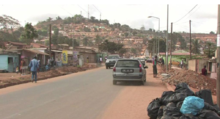
- -5.566667 12.2 3 Cabinda — the wealthy capital of oil-rich Cabinda Province
- -12.766667 15.733333 4 Huambo — the center of the Ovimbundu region, one of Angola's larger cities that suffered greatly during the civil war, surrounded by much natural beauty.
- -12.359722 13.530833 5 Lobito — a beachfront city, basically part of Benguela, which is the epicentre of Carnavale celebrations.
- -6.266667 14.25 6 M'banza-Kongo
- -14.916667 13.5 7 Lubango — a good base for exploring the mountainous escarpment in the center of southern Angola.
- Malanje — a destination owing to its proximity to tourist attractions like Kalandula Falls, Pungo Andongo, and Cangandala National Park.
- Menongue — a small city in the remote southeast, the terminus of the Moçâmedes Railway, from Namibe.
- Namibe — beachfront capital of the desert southwest, and jumping off point for exploring Iona National Park, and excursions to meet Khoisan peoples.
Other destinations [ edit ]
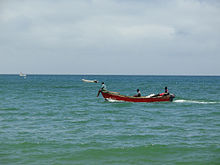
- Floresta do Maiombe — a rainforest reserve in Cabinda Province with very high biodiversity and many rivers and waterfalls.
- Great Escarpment — the steepest mountains of Angola, with scenic drives (4x4 only), opportunities for adventurous hikers, and some spectacular views, most notably the Tundavala Gap.
- -9.075833 16.003333 3 Kalandula Falls — one of Angola's most famous sights, near Malanje.
- -8.963758 13.051758 5 Mussulo Island — a beautiful extension of land in the south of Luanda that's famous for its natural beauty; explore some of its local cuisine such as ‘pirão’, funge, and moamba.
- Sumbe Caves — beautiful caves in a jungle-filled canyon near the small city of Sumbe , about four hours south of Luanda.
Understand [ edit ]
The people of Angola are stoics. They have a deep understanding of patience, and avoid blaming the difficulties the country faces on the fact that there was war. In fact, Angolans behave as if there was no war although it is deeply rooted in every Angolan. Music is the heart and soul of Angolans, it can be heard anywhere and they use anything as an excuse to party. The country has a wide range of music, mainly Kuduro, Kizomba, Semba, and Tarrachinha, the latter being more sensual than all the others. In all, it is safe to say that Angolans are fun and loving people with a thirst for more of what life has to give.
Since the end of the brutal, horrific Angolan Civil War in 2002, the Angolan government is keen on improving the country's international image and opening up Angola to the world. Tourism is still in its nascent stages and it will take some time for things to get back to normal. The country's national park system was devastated during the war, with rampant poaching leaving Angola with relatively scant megafauna compared to its African peers.
The country's tourism industry has been steadily growing and attracts 500,000–600,000 people each year. Angola shares borders with Namibia , Zambia , and the two Congos.
History [ edit ]
Before colonial rule, northern Angola was home to the Kingdom of Kongo, and the capital of it was M'banza-Kongo . The Kingdom of Kongo also had several vassal states, including the kingdoms of Ndongo and Matamba, which would unite into a powerful entity in its own right under the rule of Queen Nzinga in the 17th century.
Angola as a Portuguese colony (15th century - 1975) [ edit ]
A Portuguese explorer, Diogo Cão, first discovered the country in 1484. Sometime later, the Portuguese established a trading post at the mouth of the Congo River. The Portuguese colonialists gradually expanded their control over the region, establishing a colonial administration and exploiting Angola's resources for economic gain.
As a Portuguese colony , Angola's society and economy underwent significant transformations. The Portuguese aimed to exploit the region's vast natural resources, including minerals, timber, and agricultural products. They introduced commercial farming, particularly in the fertile northern part, focusing on cash crops such as coffee, cotton, and sisal. The Portuguese even traded enslaved people for plantations, mainly to Brazil .
The Portuguese also forced their language, culture, and religion on the people of Angola. The official language became Portuguese, and the school system was designed to integrate Angolans into Portuguese culture. Christianity, primarily Roman Catholicism, was pushed, resulting in widespread Angolan conversion. Furthermore, the influence of Portuguese culture and religion eroded native African beliefs and practices.
As the winds of change blew over Africa in the mid-twentieth century, nationalist movements in Angola arose, demanding independence from Portuguese control. The most visible of them were the Popular Movement for Angolan Liberation (MPLA), the National Front for Angolan Liberation (FNLA), and the National Union for Total Independence of Angola (UNITA). These movements fought for independence by armed confrontation, resulting in a lengthy and violent fight.
Finally, on November 11, 1975, Angola gained independence, and the MPLA established a socialist government with support from the Soviet Union and other socialist countries.
Angolan Civil War (1975 - 2002) [ edit ]
Following independence, Angola was divided into three major factions: the Marxist-Leninist People's Movement for the Liberation of Angola (MPLA), the National Union for Total Independence of Angola (UNITA), and the National Liberation Front of Angola (FNLA). Each faction had a different vision for the country's future and tried to capture power.
The civil war swiftly grew into a full-fledged struggle marked by guerilla fighting, military offensives, and massive human rights violations. The war's impact on civilians was severe, with millions displaced and massive casualties. The nation's infrastructure was severely damaged, and the war significantly influenced Angola's socioeconomic progress.
Present day (2002 - present) [ edit ]
Since the conclusion of the Angolan Civil War, the country's economy has grown, and the political situation has stabilised considerably; however, the government is still feeling the damaging effects of the civil war. Poverty, malnutrition, and disease are widespread, the standard of living for many Angolans is poor, and the country suffers from high corruption and inequality. Over 70% of Angolans live below $3.20 a day.
In August 2006, a peace treaty was signed with a faction of the FLEC, a separatist guerrilla group from the Cabinda exclave in the North, which is still active. About 65% of Angola's oil comes from that region.
Since 2017, the government has made fighting corruption its main agenda. Numerous corrupt politicians have either been jailed or are awaiting trial.
Climate [ edit ]

Like the rest of tropical Africa, Angola experiences distinct, alternating rainy and dry seasons.
The coastal strip is tempered by the cool Benguela Current, resulting in a climate similar to coastal Peru or Baja California . It is semiarid in the South and along the coast to Luanda. There is a short rainy season lasting from February to April. Summers are hot and dry, while winters are mild. The northern part has a cool, dry season (May to October) and a hot, rainy season (November to April). In the interior, above 1,000m (3,300 ft), the temperature and rainfall decrease. The interior highlands have a mild climate with a rainy season from November through April followed by a cool dry season from May to October.
The heaviest rainfall occurs in April, and is accompanied by violent storms. The far north and Cabinda enjoy rain throughout much of the year.
Electricity [ edit ]
Officially 220 V, 50 Hz. Outlets are the European standard CEE-7/7 "Schukostecker" or "Schuko" or the compatible, but non-grounded, CEE-7/16 "Europlug" types. Generally speaking, U.S. and Canadian travellers should pack a transforming adapter for these outlets if they plan to use North American electrical equipment in Angola.
Also, be aware of the power related problems in Angola. If you plan to rent a house, you for sure should rent a house with a generator. Power outages are quite frequent.
People [ edit ]
The majority of Angolans are Bantus and are home to three of its groups, including the Ovimbundu, Mbundu, and Bakongo. The Mbundu people have their roots to a 16th-century kingdom Ndongo, which had a title for rulers known as ngola , the word for the origin of the name Angola.
Books about Angola [ edit ]
There is very little literature on Angola available and most of the available literature is in Portuguese or (in some cases) French.
Bay of Tigers: An Odyssey through War-torn Angola by Pedro Rosa Mendes was translated from the Portuguese and published by Harcourt in 2003. Mendes traveled across the country by train in 1997 while the war was still going on in Angola. His account is a fascinating look at the people and the nature of life there during the war.
John Frederick Walker's A Certain Curve of Horn , documents the history of a sub species of Antelope unique to Angola - "Palanca Negra Gigante" ( Hippotragus níger variani ).
Ryszard Kapuściński authored a journalistic narrative called Another Day of Life in which he reports on the chaotic period leading up to Angola's independence from Portugal in 1975. As one of the only journalists in Angola during this very dangerous period, his perspective is rare and full of insight.
The travel writer Paul Theroux visited Angola and wrote about it in his book The Last Train to Zona Verde (2013).
Information about Angola [ edit ]
- Angola Embassy in the U.S.
Talk [ edit ]
Portuguese is the official language of Angola, the second-largest Portuguese-speaking country in the world, and is understood by virtually everyone. For clarity, Angolans speak standard Portuguese (European Portuguese).
Other commonly spoken languages include Umbundu, Kikongo, and Kimbundu. This said, those languages have been largely supplanted by the growth of Portuguese among Angolan youth.
English is not widely spoken in Angola, even though it is the most commonly studied foreign language in the country. A solid knowledge of Portuguese is essential if you wish to travel outside of Luanda or travel to Angola independently.
Get in [ edit ]
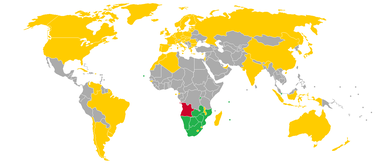
Entry requirements [ edit ]
Passport holders of the following countries do not need a visa to enter Angola when the purpose of the visit is tourism for up to 90 days (unless otherwise noted): Botswana , Mauritius , Mozambique , Namibia , Seychelles , Singapore , Zimbabwe .
From 30 March 2018, Angola started issuing tourist visas valid for 30 days in a simplified procedure to visitors from the following 59 countries: Algeria , Argentina , Australia , Austria , Belgium , Brazil , Bulgaria , Canada , Cape Verde , Chile , China , Croatia , Cuba , Cyprus , Czech Republic , Denmark , Estonia , Eswatini , Finland , France , Germany , Greece , Hungary , Iceland , India , Indonesia , Ireland , Israel , Italy , Japan , Republic of Korea , Latvia , Lesotho , Lithuania , Luxembourg , Madagascar , Malawi , Malta , Monaco , Morocco , Netherlands , New Zealand , Norway , Poland , Portugal , Romania , Russia , Sao Tome and Principe , Slovakia , Slovenia , Spain , Sweden , Switzerland , Timor-Leste , United Arab Emirates , United Kingdom , United States of America , Uruguay , Vatican City , Venezuela and Zambia .
Visitors must first apply for a pre-visa online [dead link] with the Migration and Foreigners Service and after such pre-visa is granted they can obtain a visa on arrival at Luanda Airport. In order to obtain a pre-visa applicants must submit proof of accommodation and subsistence means, a return ticket and the international certificate of vaccination. Visa costs US$120, paid on arrival.
When obtaining a visa from countries to the north, you will often only be issued a 5-day transit visa for Angola. If travelling by road, this will only give you enough time to get to Luanda where it takes up to 4 days to get another five day transit visa. If you're coming into Angola from the DR Congo, you may well need an Angolan visa before entering DR Congo.
By plane [ edit ]
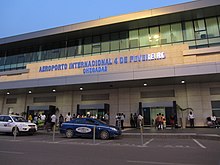
Luanda-4-de-Fevereiro is situated 4 km outside Luanda. There are public phones and bank facilities at the airport.
The most reliable taxi system from the airport is Afritaxi. Their white vehicles are clearly marked, and they charge per km or per minute, depending on how bad traffic congestion is. They only operate during daylight hours. Eco Tur also runs reliable airport transfers, but you'll need to book in advance.
- TAAG Linhas Aereas de Angola has flights between Luanda and some states in Africa, for example to South Africa ( Johannesburg ), Namibia ( Windhoek ), Zimbabwe ( Harare ), Democratic Republic of the Congo ( Kinshasa ) and the Republic of Congo ( Brazzaville ). TAAG has three weekly flights to Rio de Janeiro ( Brazil ).
- Air France flies from Paris
- Airlink flies directly from Johannesburg
- British Airways offers direct connections between London
- Brussels Airlines [dead link] flies from Brussels .
- Emirates flies directly from Dubai
- Ethiopian Airways flies from Addis Ababa
- Lufthansa [dead link] flies from Frankfurt .
- Iberia flies from Madrid .
- Kenya Airways from Nairobi
- Qatar Airways from Doha
- TAP Air Portugal [dead link] flies daily from Lisbon
- TAME [dead link] flies from Conakry
By train [ edit ]
There are no railway links between Angola and other nations.
By car [ edit ]
You can go in from Namibia at the border post near Oshikango(Namibia)/Ondjiva(Angola).
Entering from the North was, as of 2002, via Luvo, a small town on the Kinshasa-Matadi 'road'. If you want to drive through Angola, it's a real experience. Off the beaten track, road conditions might not be quite what you are used to so be prepared, particularly during the rainy season where potholes are likely to be a frequent occurrence. Also, keep a look out for livestock and the overloaded vehicles of the Angolan residents.
By bus [ edit ]
There are no bus links between Angola and other nations.
By boat [ edit ]
As of 2003, it was at least possible to enter Angola via a small passenger ferry near Rundu in Namibia. There was both an Angolan and Namibia border official present. The crossing was mostly used by Angolans for the purposes of acquiring food and other supplies in Namibia. There are (as of 2007) ferries running from the enclave of Cabinda to Luanda, which can be useful to avoid the unstable DR Congo. They carry cars as well. Seek local advice for when they depart. Sources claim that they run twice a week, cost $180 per person (bike included), and take 14 hours to do the trip (2005).
If there are no ferries, there might be cargo planes that you (and your car) can ride on between Cabinda and Luanda [1] . Be warned - these planes are unsafe. Use them at your own peril.
Get around [ edit ]
There are some bus private companies which offer services as MACOM and SGO being the biggest ones. Those companies offer a wide range of services dealing with locations one wants to travel, especially inter-provincial courses. There are lines that connect most of the major cities of the country, from the coast to the interior. Local minibus transport is not safe.

Angola’s rail system is finally being restored with the help of Chinese firms after more than 30 years of disuse. There are three main lines reflect the country's colonial past, running from the resourceful interior to the coast. They do not connect with each other.
- The northern line Caminho de Ferro de Luanda (CFL) between the capital Luanda and Malenje is back to full service. There are three classes, Primeira , with reclining leather seats with individual television sets; Exspresso , with comfortable chairs arranged in fours around tables and communal televisions; and Tramway , the cheapest option fitted out with benches to maximize passenger numbers. Ticket prices hover around 2,500 kwanzas ($26; £17). Carriges are clean and modern carriages with functioning toilets and a restaurant car. There are daily departures.
- The middle line, Caminho de Ferro de Benguela (CFB) have just started services between Lobito , Cubal and Huambo with some trains continuing to Luau at the border with Democratic Republic of Congo . There are several departures per week.
- The southern route Caminho de Ferro de Mocamedes (CFM) runs between Namibe , Lubango and Menongue .
By ferry [ edit ]
A passenger ferry links Luanda with the oil port of Soyo and the enclave of Cabinda . Timetables and operators haft shifted over the years, inquiring directly at the harbor is probably the easiest way to get information.
TAAG Angola Airlines offers scheduled flights around the country departing from Luanda to Cabinda, Catumbela, Dundo, Harare, Huambo, Kuito, Lubango, Luena, Menongue, Moçâmedes, Ondjiva, Saurimo, Soyo and Uíge
The main roads in Luanda and the provinces are in relatively good condition. However, during the rainy season (November to April), bridges and even roads can be washed away by water. When travelling outside Luanda, travel with someone who knows the local conditions, as conditions can be difficult. When travelling in rural areas, beware of landmines. There may be a shortage of petrol. Avoid driving after dark.
See [ edit ]
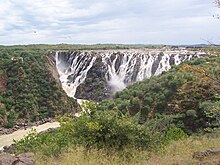
In Luanda: the Mussulo island for clean tropical beaches and water sports, the Benfica Market for Kwanza River.
Eco Tur Angola do various bespoke no tours Angola including Kissama with specialist game viewing vehicles.
In Benguela: Baia Azul for beautiful desert beaches. Art deco architecture in Benguela. Lobito City for the Restinga Peninsula and ice cold draught Cuca beer, the Benguela Rail road, and fantastic scenery.
In Kwanza Sul - Cubal Canyon, Conde Hot springs and Cachoeiras and Binga Waterfalls, with the Cambambe Dam on River Kwanza. Waku Kungo plains has fantastic scenery.
In Malange - Kalandula Waterfalls and Pungo n'Dongo Black Stones.
In Huila - Serra de Leba, Tunbda Vala Gorge, Mumuila tribespeople, fantastic scenery.
In Namibe - Arco Lagoon, beaches and a desert, and Mucubais tribespeople.
In Huambo - City Tours, Alto Hama hot springs, and fantastic scenery.
In Cunene - Himba tribes people, Ruacana Falls, and fantastic scenery.
Do [ edit ]
Buy [ edit ], money [ edit ].
The currency of Angola is the Angolan kwanza , denoted by the symbol " Kz " (ISO code: AOA ). It used to be prohibited to import or export any sum of kwanza, but now you can carry up to Kz50,000 out of the country. The kwanza (sometimes called the "new kwanza") replaced the kwanza reajustado at a rate of 1000:1 in 1995. The kwanza reajustado had replaced the novo kwanza at a rate of 1,000,000:1 in 1990. Watch out for old notes and coins.
Coins of Angola are issued in denominations of 10 and 50 cêntimos, 1, 2, 5, 10, 20, 50 and 100 kwanzas. Banknotes of Angola are issued in denominations of 1, 5, 10, 50, 100, 200, 500, 1,000, 2,000 and 5,000 kwanzas.
The kwanza lost 2/3 of its value against other currencies in 2023; prices in articles may not reflect recent inflation.
Shopping [ edit ]
Just south of Luanda, the Benfica Handcrafts Market offers the best prices for handicrafts and souvenirs. This is an open market where local artists and artisans display their products, and bargaining is not only acceptable, but recommended. The products range from sculptures and paintings to jewellery, batik cloths and accessories.
Eat [ edit ]

Generally, dining out is not very easy in Angola, since even in Luanda restaurant food is expensive and many of the less well equipped restaurants have poor hygiene. Nonetheless, Angolan cuisine is varied and tasty, with local dishes based mainly on fish, cassava products and spicy stews.
Angolan seafood is abundant and very good, and the Angolan coast is a special place to eat fresh lobster right off the fisherman's boat.
Tropical fruit in Angola is also a treat because artisan production has maintained organic methods so that rich fruit flavours, unusual to the Western palate accustomed to industrially produced tropical fruits, predominate. If, however, you are situated in Luanda and need to dine, it is recommended that you get to Ilha de Luanda, where beach-restaurants (of varying price-classes from very exclusive to rather informal) can serve most foreign needs. Restaurants in Luanda grew in numbers and quality after the 2002 ceasefire brought stability and significant investment to the country.
Be careful: when eating out, do not drink tap water, ask for bottled mineral water instead.
Not all restaurants accept US dollars in cash; ask before ordering. Credit cards will not be accepted at most restaurants, although that is rapidly changing.
Signature and national dishes [ edit ]
- Muamba de galinha (Chicken Muamba)
- Mufete de cacusso - fish rubbed with fresh lemon and pepper
- Mufete - grilled fish of your choice (type of fish subject to availability) with boiled sweet potatoes and a mixture of raw finely chopped onions, peppers and tomatoes. Locals like to add beans as a side dish.
- Calulu a maneira com Funge de bombo
- Pirão ou funge - polenta made of corn meal and cassava roots. It is also served as the main meal in homes during Christmas.
Drink [ edit ]
Sleep [ edit ].
World class hotels include the Tropico Hotel, the Alvalade Hotel, Le President Meridien Hotel, the Continental Hotel, the Skyna Hotel, the Epic Sana hotel, and the Palm Beach Hotel, among others.
Stay safe [ edit ]
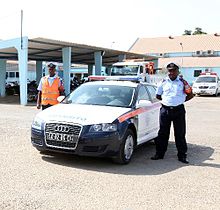
You should consider hiring a trusted and knowledgeable local guide for travel within Angola, although if you follow some basic rules then travelling in Angola isn't dangerous. Travelling after dark and alone is never a good idea. If possible, join with several cars of the same make and model because of the possible need of spare parts.
Never step beyond the red and white HALO Trust posts. These denote mine fields . In fact, beware of anything surrounded by any kind of red stones or similar markers.
In Angola, it is mandatory to have a form of identification on you at all times. What this means: carrying a certified copy of your passport or your national identification card.
Crime [ edit ]
Angola has a high crime rate. Carjackings, muggings, robberies, sexual assaults, and the like are not unheard of in the capital city, Luanda .
Being a tourist will, undoubtedly, make you an "easy" target for criminals. Having little to no knowledge of Portuguese will also make you stand out. You can drastically reduce the likelihood of being a crime victim by applying a modicum of common sense — don't display signs of affluence, don't flash around your gadgets, keep your valuables and belongings out of reach, don't go to unfamiliar areas, don't go out at night, dress conservatively, and don't be too trusting of people you don't know.
If you've been sexually assaulted, immediately seek medical attention; Angola has a high HIV/AIDS prevalence rate.
Political unrest [ edit ]
Angola has a long history of political instability and unrest.
Be careful with voicing your political opinions in public or on social media; disrespecting government officials is a punishable offence in Angola. This also encompasses complaining about how government officials and authorities are carrying out their duties.
Photography [ edit ]
Given Angola's history of enduring civil conflict, perceived threats to national security are taken very seriously in Angola. Taking photographs of certain structures and individuals — government buildings, military installations, train stations, police officers, airfields, airports, and bridges — will land you in serious trouble with the Angolan authorities and they may (incorrectly) assume you're a spy or a terrorist.
Stay healthy [ edit ]
State-of-the-art medical care is virtually non-existent in Angola; the country has one of the lowest average life expectancies in the world, the country is ideal for many tropical diseases, and a significant portion of Angolans are too poor to afford healthcare.
Malaria is the leading cause of death in the country. Regularly use insect repellent to lower your chances of contracting malaria, and consider draping a mosquito net (if you have one) over your bed. It's strongly recommended to get vaccinated against malaria before travelling to Angola.
Do not drink tap water . There is no working water purification system in Angola. Stick to bottled water.
Yellow fever is prevalent in the country. You are normally required to get vaccinated against the disease before applying for an Angolan visa and/or travelling to the country.
Dengue fever is another major health threat.
The country's HIV/AIDS prevalence rate among adults is 1.80% . Although it is low compared to other African nations, you should always be aware of your surroundings.
Respect [ edit ]
Since Angola is rarely visited by tourists, you may attract unwanted attention from the locals. This isn't to indicate hostility, it is to indicate curiosity.
As is the case throughout Africa , it is obligatory to show respect for elders (including authority figures) as they're generally viewed as wiser and more experienced. When visiting an Angolan home, it is customary to greet the oldest person first. If you're waiting to enter a building, allow someone older to go in first. If you're on public transportation, give up your seat for someone older than you.
Angolans are extremely hospitable and they consider it impolite to not give someone a good welcome. Therefore, you can expect to be treated with immense respect as a visitor. If you've been invited for a meal at an Angolan person's home, bear in mind that the oldest person in the house starts eating first.
Angolans are attentive listeners . They consider it extremely rude to interrupt someone's conversation.
If travelling to rural areas, take some time to greet the local soba (chief with government-backed authority). Words of kindness will allow you to enjoy your journey in peace.
Angolans are generally amiable, and it is important to greet everyone respectfully and immediately upon seeing them. A simple hello ("Bom dia") will do.
Connect [ edit ]
The phone country code of Angola is +244. Telephone connections, cellular and landline, are heavily overloaded, making communication difficult at times. International lines are, however, often better.
Carry a satellite telephone in the case of a breakdown or other emergency. Be aware, that while Iridium [2] satellite phones have global coverage, Thuraya satellite phones have coverage in most of Angola, but may not have coverage in the southern parts of the country.
- Has custom banner
- Banner missing from Wikidata
- Has map markers
- City listing with no coordinates
- Vicinity listing with no coordinates
- Articles with dead external links
- Has Geo parameter
- Central Africa
- All destination articles
- Outline countries
- Outline articles
- Country articles
- Pages with maps
Navigation menu
Top Things to Do in Angola - Angola Must-See Attractions
Things to do in angola, explore popular experiences, popular cities in angola.

Top Attractions in Angola

Nature and Wildlife Tours

Cultural Tours

Historical Tours
Multi-day tours.

Tours & Sightseeing
What travellers are saying.
Top Angola Attractions
Things to do in angola, explore popular experiences, popular cities in angola.

Top Attractions in Angola

Nature and Wildlife Tours

Cultural Tours

Historical Tours
Multi-day tours.

Tours & Sightseeing
What travellers are saying.
- BUCKET LISTS
- TRIP FINDER
- DESTINATIONS
- 48HR GUIDES
- EXPERIENCES

- DESTINATIONS South Carolina 3 Ways to Get Wet and Wild in Myrtle Beach BY REGION South America Central America Caribbean Africa Asia Europe South Pacific Middle East North America Antarctica View All POPULAR Paris Buenos Aires Chile Miami Canada Germany United States Thailand Chicago London New York City Australia
- EXPERIENCES World Wonders 14 Landmarks That Should Be Considered World Wonders BY EXPERIENCE Luxury Travel Couples Retreat Family Vacation Beaches Culinary Travel Cultural Experience Yolo Winter Vacations Mancations Adventures The Great Outdoors Girlfriend Getaways View All POPULAR Cruising Gear / Gadgets Weird & Wacky Scuba Diving Skiing Hiking World Wonders Safari
- TRIP FINDER Peruvian Amazon Cruise BY REGION South America Central America Caribbean Africa Asia Europe South Pacific Middle East North America Antarctica View All POPULAR Colors of Morocco Pure Kenya Costa Rica Adventure Flavors of Colombia Regal London Vibrant India Secluded Zanzibar Gorillas of Rwanda
- Explore Bucket Lists
- View My Bucket Lists
- View Following Bucket Lists
- View Contributing to Lists
Angola — Attractions

Attractions in Angola mean uncovering hidden wonders of the coasts, interior highlands and wilderness, as well as getting to know a unique culture that has been untouched through the years. Luanda’s Mussulo Island is dotted with pleasant beaches, but the bulk of the gorgeous stretches of sand are in Benguela, where old colonial Portuguese ruins also stand. The Namib Desert is a picture-perfect setting, while the hidden waterfalls within the forests are simply to die for.
Iona National Park
The largest of its kind in Angola, Iona National Park is one of the most visited attractions in the country. It spans 5,850 square miles and was a true animal paradise before the pre-civil war days. Efforts are being undertaken to revive its once thriving wildlife population that was sadly killed off due to extensive poaching. Throughout the park are magnificent rock formations for picturesque views and photos. Address: Namib Province, Angola Phone: n/a Website: n/a
Angola’s capital, Luanda (on the country’s Atlantic coast) is blessed with beautiful beaches, colonial ruins, historic monuments, museums, and a wide range of things to do and places to explore. Water sporting along the tropical beaches of Mussulo Island and shopping in the famed Benfica Handcrafts Market are just some of the favorite pastimes in Luanda. Address: Luanda Province, Angola Phone: n/a Website: n/a
Lubango City is the capital of the south. It is known for its lush tropical valley dominated by the iconic Statue of Christ, which stands on a cliff overlooking the city. The town has one of the largest preserves of colonial architecture in Angola. Address: Huila Province, Angola Phone: n/a Website: n/a
Leba Mountain Pass
Daredevils shouldn’t miss the spiraling roads of Leba Mountain Pass. Reaching as high as 5,000 feet in altitude, the trip from Lubango to Namibe is a thrilling joy ride. The forested mountains and cascading waterfalls are in stark contrast to the dull desert below providing a breathtaking backdrop. Address: Huila Province, Angola Phone: n/a Website: n/a
Lake Arco is a freshwater oasis with superb rock formations. It is home to a diverse range of bird life, flora and fauna and a traditional farming community. Address: Namib Desert, Angola Phone: n/a Website: n/a
Namib Desert
Dubbed the oldest desert on earth, Namib is a spectacular stretch of sand dunes and rock formations spanning from Tombwa to Walvis Bay in Namibia. Bisected by the Cunene River, the Namib Desert is awash in red sand spanning the coast. Address: Namibe Province, Angola Phone: n/a Website: n/a
Home to the most stunning beach stretches in Angola, the Baia Azul area boasts breathtaking desert-scapes. The town is also known for its Art Deco architecture, historic railroad, verdant lands, and superb scenery. Address: Central Angola Highlands Phone: n/a Website: n/a
Kwanza Sul is the largest coffee producer in the country. It is made up of the Waku Kungo plains, the River Kwanza, the Cambambe Dam, Conde Hot Springs, and the Binga Waterfalls. The beautiful Cubal Canyon is also a must-see, as are the ruins of age old fortresses and cave paintings dating back to the Neolithic era. Address: Kwanza Sul Province, Angola Phone: n/a Website: n/a
The port town of Namibe has a unique combination of beach and desert. It offers the best access to Arco Lagoon, as well as certain parts of Iona National Park. Within the city are beautiful fortresses and old churches. The town is a good place to visit if you want a glimpse into the lives of the Mucubais tribe people. Address: Namibe Province, Angola Phone: n/a Website: n/a
Click here to learn about Angola's Food and Restaurants
- Things To Do
- Attractions
- Food And Restaurants
- Shopping And Leisure
- Transportation
- Travel Tips
- Visas And Vaccinations
- History And Culture
- Festivals And Events
World Wonders
These are the most peaceful countries on the planet, the great outdoors, deserts in bloom: 6 spots for springtime wildflower watching, how to plan a luxury safari to africa, british columbia, yoho national park is the most incredible place you've never heard of.
- Editorial Guidelines
- Submissions
The source for adventure tourism and experiential travel guides.

IMAGES
VIDEO
COMMENTS
This place is great to view, is one of the best of Angola. Nice place to relax and view the cars and appreciate the... See way to experience (1) 5. Kalandula Falls. 57. Waterfalls. Kalandula Falls (formerly Duque de Braganca Falls) are waterfalls in the municipality of Kalandula, Malanje Province, Angola. On the Lucala River, the falls are 105 ...
6. Benguela. Source: Luis Fernandes VX / shutterstock. Benguela. The city of Benguela in western Angola is situated on a bay of the same name and is an important tourist destination for the country. The early economy of the city was established on mining and then the slave trade to Cuba and Brazil.
Worth a visit. The Currency Museum - things to do in Angola. S. Miguel Fort - The fort is at the top of a small hill, so you must climb a "few" stairs. However, you will be rewarded with a fantastic view of the Marginal, the island, and the city. Angola Tourist attractions - S. Miguel Fort.
See way to experience (1) 5. Kalandula Falls. 57. Waterfalls. Kalandula Falls (formerly Duque de Braganca Falls) are waterfalls in the municipality of Kalandula, Malanje Province, Angola. On the Lucala River, the falls are 105 meters (344 feet) high and 400 meters (1,300 feet) wide.
For most people, Angola is one of Africa's last great travel mysteries. Despite its elemental landscapes and boom-bust oil-dependent economy, the country remains closed off to all but the most adventurous travellers thanks to stringent visa policies, high prices and a history that's been more about war than peace. 01 / Attractions.
Mausoleum Of Agostinho Neto. 23 Best Places to Visit in Angola 28. The Agostinho Neto Mausoleum is the final resting place of the first president of Angola. This monumental structure is a striking architectonic masterpiece and a symbol of national pride for Angolans.
South Africa. Morocco. Kenya. Tanzania. Egypt. Discover the best attractions in Angola including Parque Nacional da Kissama, Museu de Antropologia, and Museu Central das Forças Armadas.
Angola offers a diverse range of attractions and natural wonders for tourists to explore. Here are some must-see places when visiting Angola: Kalandula Falls: Located in the province of Malanje, Kalandula Falls is one of the largest waterfalls in Africa. The sight of water cascading down the rocks amid lush greenery is breathtaking.
6. Kissama National Park. Kissama National Park is a wildlife lover's dream come true. Located just south of Luanda, it's one of the most beautiful places to visit in Angola for those who want to experience Africa's iconic fauna.
12. Kalandula Falls. Tourist Attractions in Angola. Photo/wikipedia. Prepare to be amazed by the magnificent Kalandula Falls, often considered one of the most impressive falls in Africa after Victoria Falls. Located in the Lucala River, these falls stand over 100 meters high and stretch 400 meters wide.
There are also plenty of things to do both in the city and just outside of it. Lets explore the best things to do in Luanda: 1. Visit the Saint Michael Fortress. Source: afrotourism. Saint Michael Fortress. This Portuguese fortress was built in 1576 by Angola's first Captain-Governor Paulo Dias de Novais.
In this comprehensive travel guide, we'll delve into the 15 best places to visit in Angola, providing you with insights into each destination's beauty, and history, and what to expect during your journey. 1. Luanda: The Capital of Contrasts. Luanda, Angola's capital, is a city of remarkable contrasts.
4 Kissama National Park — Angola's most accessible park, near Luanda, with accommodations for tourists. -8.963758 13.051758. 5 Mussulo Island — a beautiful extension of land in the south of Luanda that's famous for its natural beauty; explore some of its local cuisine such as 'pirão', funge, and moamba.
See way to experience (1) 5. Kalandula Falls. 57. Waterfalls. Kalandula Falls (formerly Duque de Braganca Falls) are waterfalls in the municipality of Kalandula, Malanje Province, Angola. On the Lucala River, the falls are 105 meters (344 feet) high and 400 meters (1,300 feet) wide.
The tourism industry in Angola is based on the country's natural environment, including its rivers, waterfalls and coastline. Angola's tourism industry is relatively new, as much of the country was ravaged during the post-colonial civil war which ended in 2002. Visitor attractions Cameia ...
Things to Do in Angola, Africa: See Tripadvisor's 11 537 traveller reviews and photos of Angola tourist attractions. Find what to do today, this weekend or in April. We have reviews of the best places to see in Angola. Visit top-rated & must-see attractions.
The largest of its kind in Angola, Iona National Park is one of the most visited attractions in the country. It spans 5,850 square miles and was a true animal paradise before the pre-civil war days. Efforts are being undertaken to revive its once thriving wildlife population that was sadly killed off due to extensive poaching.
Venture into the heart of Angola, a dynamic African nation where the Portuguese influences of Luanda, the natural beauty of the Kalandula Falls, and the powerful beats of Kizomba music harmonize. Explore the colonial architecture of Luanda, marvel at the towering waterfalls in Malanje, or dance to the sultry rhythms of Angolan music.
Rich cultural experiences, exceptional encounters and marvellous scenery are just waiting to be discovered in Angola. With desert, coastal roads, beaches and...
Top Tourist Places in Angola. Below is the list of top Attractions places in Angola: 1. Luanda. Luanda, the vibrant capital of Angola, stands as a dynamic metropolis on the Atlantic coast. Luanda, well-known for combining modern development with ancient elegance, is a fascinating tourist destination since it exhibits a distinctive blending of ...
Tundavala Gap (Lubango) Tundavala Gap is one of the best places to go in Lubango, Angola. A wonderfully undiscovered natural wonder! One-kilometer high rock with a short gap or a lush green meadow underneath. The 2.200-meter-high Tundavala Gap in Angola is a popular trekking destination.